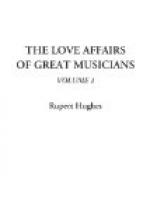Hawkins guesses that Purcell was married young, because at the age of twenty-five he was advertising the sale of his first sonatas at his own house; also that, musician-like, he left his family dependent upon the favour of his benefactors, particularly upon the graciousness of his pupil and patroness, Lady Elizabeth Howard, who placed on his tomb in Westminster Abbey the famous inscription often credited to Dryden: “Here lyes Henry Purcell, Esq.; who left this life, and is gone to that blessed place, where only his harmony can be exceeded.”
We now know that Purcell’s marriage was either in 1680 or 1681, when he was twenty-two or twenty-three years old. August 2d, 1682, Purcell’s father, a venerable and distinguished musician and a friend of Pepys, the diarist, was buried in Westminster Abbey, where later his more distinguished son was laid. A few days after the elder Purcell’s burial, Henry and his wife came to Westminster Abbey again, for the baptism of a son new-born. He died in a few months and a third time they came to the sad old abbey to lay their child in the cloisters there.
The next year, 1683, a second son died, and in 1687 a third boy two months old was buried in the cloisters of the abbey. This monotonous return of the hand of death must have embittered the life of these two, who seem to have remained lovers always. But in May, 1688, a daughter was born, named Frances after her mother; and she outlived both parents. She married a poet, when she and her lover were each nineteen, and named a child Frances after the grandmother. On Sept. 6th, 1689, Henry Purcell’s son Edward was baptised, and he also lived to attain some distinction as an organist. In 1693 a daughter, Mary Peters, was born.
Two years later, on May 21st, 1695, the young father died—on the eve of St. Cecilia’s Day. At his bedside were his old mother, his young wife, and the two little children. Purcell was buried under the organ of Westminster Abbey and the anthems he had composed for the funeral of Queen Mary were sung at his own. And there he rests near his fellow musician, Pelham Humphries, who lies, as Runciman says, “by the side of his younger wife in the Thames-sodden vaults of Westminster Abbey.”
Purcell’s will, made the very day of his death, was as follows:
“In the name of God, Amen. I, Henry Purcell, of the Citty of Manchester, gent., being dangerously ill as to the constitution of my body, but in good and perfect mind and memory (thanks be to God), doe by these presents publish and declare this to be my last Will and Testament.




